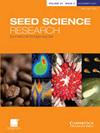Relationship of the lateral embryo (in grasses) to other monocot embryos: a status up-grade
IF 1.9
3区 生物学
Q2 PLANT SCIENCES
引用次数: 2
Abstract
Abstract Martin placed the lateral embryo, which occurs only in grasses, adjacent to the broad embryo at the base of his family tree of seed phylogeny. Since Poales and Poaceae are derived monocots, we questioned the evolutionary relationship between the lateral embryo and other kinds of monocot embryos. Information was compiled on embryo and seed characteristics for the various families of monocots, kind of embryogenesis for families in Poales and germination morphology of families with lateral (only Poaceae) and broad embryos. The kinds of monocot embryos are broad, capitate, lateral, linear fully developed, linear underdeveloped and undifferentiated, but only broad and lateral embryos are restricted to Poales. Asterad embryogenesis occurs in Poaceae with a lateral embryo and in Eriocaulaceae, Rapataceae and Xyridaceae with a broad embryo. In developing grass seeds, the growing scutellum (cotyledon) pushes the coleoptile, mesocotyl and coleorhiza to the side. In the organless broad embryo, the cotyledonary sector is larger than the epicotyledonary sector. During germination of grass seeds, the coleorhiza and then the coleoptile emerge, while in a seed with a broad embryo the elongating cotyledon pushes the epicotyledonary sector outside the seed, after which a root–shoot axis is differentiated at a right angle to the cotyledon inside the seed. Broad and lateral embryos are closely related; however, the lateral embryo is more advanced in seed/embryo traits and germination morphology than the other kinds of monocot embryos, suggesting that its position on the family tree of seed phylogeny should be higher than of the other monocot embryos.侧边胚(禾本科)与其他单子叶胚的关系:地位的提升
摘要Martin在其种子系统发育家谱的基础上,将仅发生在草中的侧胚与宽胚相邻。由于Poales和Poaceae都是单子叶植物,我们质疑侧胚与其他类型单子叶植物胚胎之间的进化关系。汇编了有关单子叶植物各科的胚胎和种子特征、Poales科的胚胎发生类型以及具有侧胚(仅Poaceae)和宽胚的科的发芽形态的信息。单子叶胚的种类有宽胚、头状胚、侧胚、完全发育的线形胚、发育不全的线形胚和未分化的线形胚,但只有宽胚和侧胚仅限于Poales。紫星胚胎发生发生在具有侧胚的波科和具有宽胚的Erioculaceae、Rapataceae和Xpyridaceae中。在草籽发育过程中,生长中的盾叶(子叶)将胚芽鞘、中胚轴和胚芽鞘推向一边。在无器官的宽胚中,子叶扇区大于上胚轴扇区。在草籽发芽过程中,胚芽鞘和胚芽鞘出现,而在具有宽胚的种子中,伸长的子叶将上胚轴部分推到种子外部,之后根冠轴与种子内部的子叶成直角分化。宽胚和侧胚关系密切;然而,侧胚在种子/胚胎性状和发芽形态上比其他类型的单子叶植物胚胎更先进,这表明它在种子系统发育家族树上的地位应该高于其他单子叶植物胚。
本文章由计算机程序翻译,如有差异,请以英文原文为准。
求助全文
约1分钟内获得全文
求助全文
来源期刊

Seed Science Research
生物-植物科学
CiteScore
3.60
自引率
4.80%
发文量
23
审稿时长
>12 weeks
期刊介绍:
Seed Science Research, the official journal of the International Society for Seed Science, is a leading international journal featuring high-quality original papers and review articles on the fundamental aspects of seed science, reviewed by internationally distinguished editors. The emphasis is on the physiology, biochemistry, molecular biology and ecology of seeds.
 求助内容:
求助内容: 应助结果提醒方式:
应助结果提醒方式:


